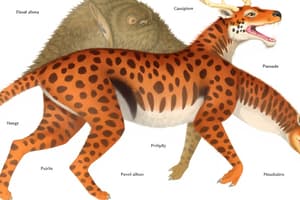Podcast
Questions and Answers
Which characteristic is unique to mammals?
Which characteristic is unique to mammals?
- Feathers
- Fur or hair (correct)
- Cold-blooded
- Scaly skin
What is the primary function of gills in fish?
What is the primary function of gills in fish?
- To facilitate breathing (correct)
- To absorb nutrients
- To aid in swimming
- To help regulate body temperature
Which of the following groups of animals is cold-blooded?
Which of the following groups of animals is cold-blooded?
- Birds
- Amphibians
- Mammals
- Reptiles (correct)
What term describes the variety of animal species within ecosystems?
What term describes the variety of animal species within ecosystems?
Which type of reproduction involves the combination of genetic material from two parents?
Which type of reproduction involves the combination of genetic material from two parents?
What is an example of an invertebrate?
What is an example of an invertebrate?
Which animal is known for its ability to regenerate lost limbs?
Which animal is known for its ability to regenerate lost limbs?
What is a key feature of social structures in animal behavior?
What is a key feature of social structures in animal behavior?
Study Notes
General Classification of Animals
- Kingdom Animalia: Multicellular, eukaryotic organisms.
- Phylum: Major groupings (e.g., Chordata, Arthropoda).
- Classes: Further divisions within phyla (e.g., Mammalia, Aves).
Major Animal Groups
- Mammals:
- Characteristics: Warm-blooded, fur or hair, mammary glands.
- Examples: Humans, dolphins, elephants.
- Birds:
- Characteristics: Feathers, beaks, lay eggs.
- Examples: Eagles, penguins, sparrows.
- Reptiles:
- Characteristics: Cold-blooded, scaly skin, lay eggs.
- Examples: Snakes, lizards, turtles.
- Amphibians:
- Characteristics: Life cycle includes aquatic and terrestrial stages.
- Examples: Frogs, salamanders, toads.
- Fish:
- Characteristics: Gills for breathing, fins for swimming, lay eggs.
- Examples: Salmon, sharks, goldfish.
- Invertebrates:
- Characteristics: Lack a backbone, diverse forms.
- Examples: Insects, arachnids, mollusks.
Key Concepts
- Biodiversity: Variety of animal species within ecosystems; crucial for ecological balance.
- Adaptation: Physical or behavioral traits that enhance survival in specific environments.
- Habitat: The natural environment where an animal lives; includes factors like climate and food sources.
- Food Chains: Illustrate the flow of energy and nutrients through ecosystems (producers → consumers → decomposers).
Animal Behavior
- Instinct: Innate behaviors performed without prior experience.
- Learned Behavior: Actions acquired through experience or observation.
- Social Structures: Group dynamics in species (e.g., packs in wolves, pods in dolphins).
Reproduction
- Sexual Reproduction: Involves the combination of genetic material from two parents.
- Asexual Reproduction: Offspring arise from a single organism (e.g., budding in hydra).
- Life Cycles: Stages through which an animal develops (e.g., egg, larva, adult).
Conservation
- Endangered Species: Animals at risk of extinction due to habitat loss, poaching, climate change.
- Conservation Efforts: Initiatives aimed at protecting wildlife (e.g., habitat restoration, legal protections).
Interesting Facts
- The Blue Whale is the largest animal on Earth.
- Some amphibians can regenerate lost limbs.
- The octopus has three hearts and blue blood.
General Classification of Animals
- Kingdom Animalia includes multicellular, eukaryotic organisms.
- Phylum represents major groupings of animals; notable examples include Chordata (vertebrates) and Arthropoda (invertebrates).
- Classes represent subdivisions within each phylum, such as Mammalia for mammals and Aves for birds.
Major Animal Groups
-
Mammals:
- Key traits include warm-bloodedness, presence of fur or hair, and mammary glands.
- Examples include humans, dolphins, and elephants.
-
Birds:
- Distinguished by feathers, beaks, and the ability to lay eggs.
- Examples include eagles, penguins, and sparrows.
-
Reptiles:
- Cold-blooded with scaly skin, primarily reproduce by laying eggs.
- Examples include snakes, lizards, and turtles.
-
Amphibians:
- Unique life cycle features both aquatic and terrestrial stages.
- Examples include frogs, salamanders, and toads.
-
Fish:
- Aquatic animals that breathe through gills and use fins for swimming; primarily reproduce by laying eggs.
- Examples include salmon, sharks, and goldfish.
-
Invertebrates:
- Lack a backbone and exhibit a diverse array of forms.
- Examples include insects, arachnids, and mollusks.
Key Concepts
- Biodiversity: Essential for ecological balance, representing the variety of species in ecosystems.
- Adaptation: Traits developed that improve survival chances in specific environments.
- Habitat: Refers to an animal's natural living environment, including climate and food.
- Food Chains: Depict the energy and nutrient flow through ecosystems, showing relationships between producers, consumers, and decomposers.
Animal Behavior
- Instinct: Refers to innate behaviors automatic and not learned through experience.
- Learned Behavior: Actions developed from experience or observational learning.
- Social Structures: Dynamics of groups within species, such as packs in wolves or pods in dolphins.
Reproduction
- Sexual Reproduction: Involves two parents combining genetic material to produce offspring.
- Asexual Reproduction: Offspring arise from a single parent, like budding seen in hydras.
- Life Cycles: Stages of development through which animals progress, including egg, larva, and adult stages.
Conservation
- Endangered Species: Refers to species at high risk of extinction resulting from habitat destruction, poaching, and climate changes.
- Conservation Efforts: Initiatives to protect wildlife, encompassing habitat restoration and legal protections to ensure species survival.
Interesting Facts
- The Blue Whale holds the title of the largest animal ever known to exist on Earth.
- Certain amphibians possess the unique ability to regenerate lost limbs.
- The octopus is remarkably distinct with three hearts and blue-tinted blood.
Studying That Suits You
Use AI to generate personalized quizzes and flashcards to suit your learning preferences.
Description
This quiz delves into the classification of animals within the Kingdom Animalia, covering major groups such as mammals, birds, reptiles, amphibians, fish, and invertebrates. Test your knowledge on their characteristics and examples to better understand the diversity of life forms in the animal kingdom.




